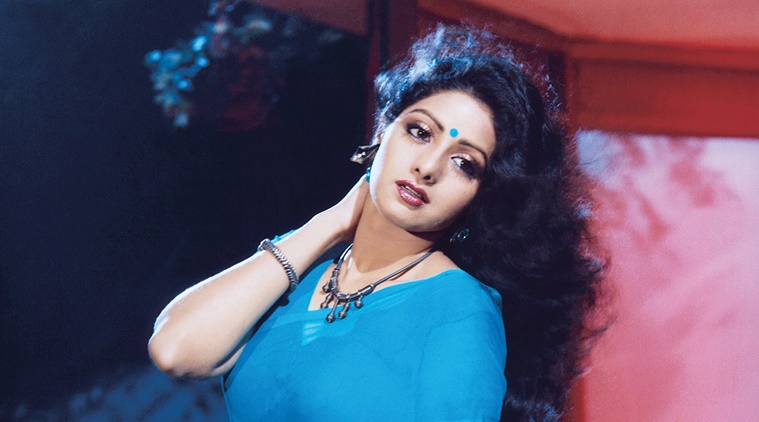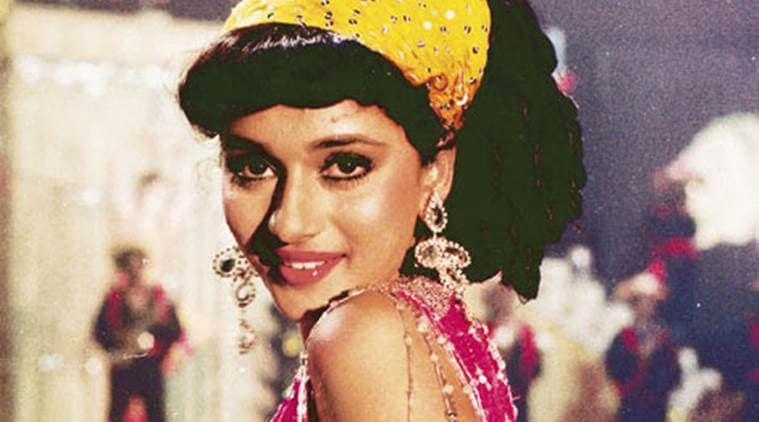
It was the April 1986 cover of Filmfare that announced Madhuri Dixit as ‘The New Sensation.’
Not that it created a tremor in Sridevi’s life. ‘New sensations’ like Kimi Katkar, Meenakshi Seshadri, Sonam, Padmini Kolhapure, Bhanupriya, et al were routinely making waves by then, but that hardly affected Sridevi because she was in a place all her own. After Himmatwala, she had been giving steady hits with Jaani Dost, Maqsad, Mawaali and Justice Chaudhury, among others, mostly remakes from the south with Jeetendra as the lead. Every third Sridevi film was a hit at the time. Of course there were debacles like Aag aur Shola and Balidaan and, later, Sultanat (whose claim to fame was the disastrous debut of Karan Kapoor) and Bhagwaan Dada (in which Sridevi does a dance number with Hrithik Roshan as a child artiste). However, she badly needed a solo blockbuster to up her game. Nagina was released in November 1986 and declared the fluke hit of the decade. The March 1987 cover of Filmfare screamed ‘devastating’ and had Sridevi on the cover. She was now officially the highest paid star after Amitabh Bachchan.
Producer-director Manmohan Desai said in an interview to Filmfare in the same issue, ‘With Nagina, Sridevi has shot out of the reach of most filmmakers. I can’t afford to cast her in an Amitabh starrer any more. It’s too risky a combination. Without bringing me extra moolah, it will increase the risk.” It was true. Sridevi had the power of the initial draw. Her name was enough to guarantee queues on opening day. Distributors were willing to buy a Sridevi movie as soon as it was announced. She could outlive even the most inept direction.
She followed it up with Mr India in 1987, a movie which proved her versatility as an out and out entertainer. Drama, comedy, song and dance, sex appeal—she had the whole package. Then with Chandni and ChaalBaaz (1989), she took her box office dependability to a whole new level where she outperformed all her competitors. Of course, she couldn’t salvage everything that she appeared in—certainly not the grotesque Himmat aur Mehanat or Watan ke Rakhwale, Sone pe Suhaaga or Pathar ke Insan. Meanwhile, Madhuri, who was just four years younger to Sridevi, was still on a slow start. After her disastrous debut in Abodh (1984), she had a string of flops and was playing second and third lead in movies like Awara Baap, Swati, Manav Hatya and Mohre. Then Subhash Ghai signed her on for Uttar Dakshin (1987) and Ram Lakhan (1989). At the time, her secretary Rikku Rakesh Nath handled Anil Kapoor’s work, so he spoke to Boney Kapoor (Anil’s brother) about her. ‘Boney took me to Subhash Ghai’s office once, and all of us sat down together to decide how we would promote her. We decided to give an advertisement in Screen magazine, listing the names of producers like Shashi Kapoor, F.C. Mehra, Yash Chopra and Ashok Thakeria who were going to work with her. Most of them did not work with her, but we gave the ad anyway,’ said Rikku in an interview to Rediff.com. There was a time when Madhuri was willing to do even a small role in a Sridevi film if she was comfortable with the character.

One thing led to another and soon, Madhuri had signed Tezaab with N. Chandra, opposite Anil Kapoor. “Ek do teen” became a trailblazer and Anil Kapoor was now touting her as the next big thing. Although after Tezaab, she appeared for just fifteen minutes in Ram Lakhan and had a five-minute cameo in Tridev (both released in 1989). Then the nineties came and things changed. Movies became more teenybopper-ish—Qayamat Se Qayamat Tak, Maine Pyar Kiya, Jo Jeeta Wohi Sikandar, Hum Aapke Hai Kaun—heroes got younger, the Khans had made their entry. Madhuri was touted as this young beauty—a photographer’s delight, with a near perfect face, amazing dancing skills and a thousand-watt smile. She was a trained Kathak dancer and spoke Hindi well, though she could not match Sridevi’s versatility or comic timing. Post 1989, Sridevi couldn’t quite raise the bar. Her songs were not working the same magic as before, while Madhuri always had memorable song-and-dance sequences in each of her films. Even in her flop films, Madhuri’s item numbers stood out: Sailaab (1990) with “Humko aajkal hai intezar”, Anjaam (1994) with “Chane ke khet mein”, Yaraana (1995) with “Mera piya ghar aaya”, etc. Madhuri was a choreographer’s delight and her songs outlived the movies she did. By the early nineties, there were clearly two camps: the Sridevi camp and the Madhuri camp. Madhuri was becoming the toast of Bollywood’s leading men, like Anil Kapoor, Sunny Deol, Jackie Shroff, Govinda, Aamir Khan, Shah Rukh Khan, Salman Khan, Sanjay Dutt, even an ageing Vinod Khanna; while Sridevi was getting restricted to Anil Kapoor and Rishi Kapoor, now that Jeetendra’s career was over and she was no longer doing films with Mithun. Sridevi’s Hindi (and her pronunciation) now began to matter because Madhuri had perfect diction. Post Chandni and ChaalBaaz (1989), Sridevi had no solo hits or blockbusters in Bollywood for a while, although she was still shining in the south; while Madhuri was on a roll with Dil, Saajan, Beta, Thanedaar and Khalnayak. Then came Hum Aapke Hain Kaun (1994), which took Madhuri to superstardom, being India’s biggest blockbuster at 300 crores.
Ironically, Beta, Madhuri’s big blockbuster, was offered to Sridevi first and she turned it down. It ended up being a major hit in 1992 and consolidated Madhuri’s position at a time when Sridevi’s was slipping. Beta was written specifically for Sridevi; they’d even incorporated the song “Dhak dhak karne laga” for her. It was the Hindi version of the Telugu song “Abbanee tiyyani” from Jagadeka Veerudu Athiloka Sundari, Sridevi’s blockbuster movie with Chiranjeevi, which was released in 1990. Even Dil To Pagal Hai, which Yash Chopra offered to Sridevi first in 1994, ended up resurrecting Madhuri’s career in 1997 after the arrival of Karisma Kapoor and Raja Hindustani (1996). I was never a big Madhuri fan, and have trouble recalling what she wore in her various item numbers, except in Sailaab. For “Dhak dhak” I remember it was something yellow, and I do remember her hair was always billowy. I also remember Sridevi was far more sensuous, with fewer chest thrusts in “I love you”, and somehow “Dhak dhak” seemed hugely inspired by it—from the lighting to the haystack. With Sridevi, I remember every aspect of the ensemble in all her dances—wigs, headgear, feather dusters, the whole hog. Her songs came alive with the tiniest of details—sneezing to a feather duster here, an eye roll there, a cross eye here. I think visually Sridevi left a deeper mark. I am not talking beauty here. Madhuri was definitely a better dancer, but Sridevi had the real flair for performance.
Post Chandni, Sridevi had metamorphosed into a slim, sophisticated chiffon-clad siren. We saw shades of this even in Khuda Gawah, where she played mother and daughter, or Gumrah, where she plays an innocent girl arrested on drug charges, or even Mr Bechara (where nothing other than her made sense). In the ’90s, Sridevi did fewer films, as her focus was on family. Despite that, she still reigned supreme, and commanded her price. Post Chandni there were a series of flops—Lamhe, Pathar Ke Insan, Farishtay, Naaka Bandi and the biggest disasters of all—Roop Ki Rani Choron Ka Raja and Heer Ranjha.
She did have hits like Khuda Gawah, Laadla, Gumrah and Judaai, but they came nowhere near the magnitude of her ’80s magic. It was time for Sridevi to move on. Perhaps marriage and motherhood gave her the legitimate exit option she was looking for and she took it gracefully post 1996.
Ironically, two years later, Madhuri left the industry to get married and move to Denver with her husband. It was as if she was following in Sridevi’s footsteps.
(Excerpted with permission from Sridevi: Queen of Hearts by Lalita Iyer, Westland Books.)